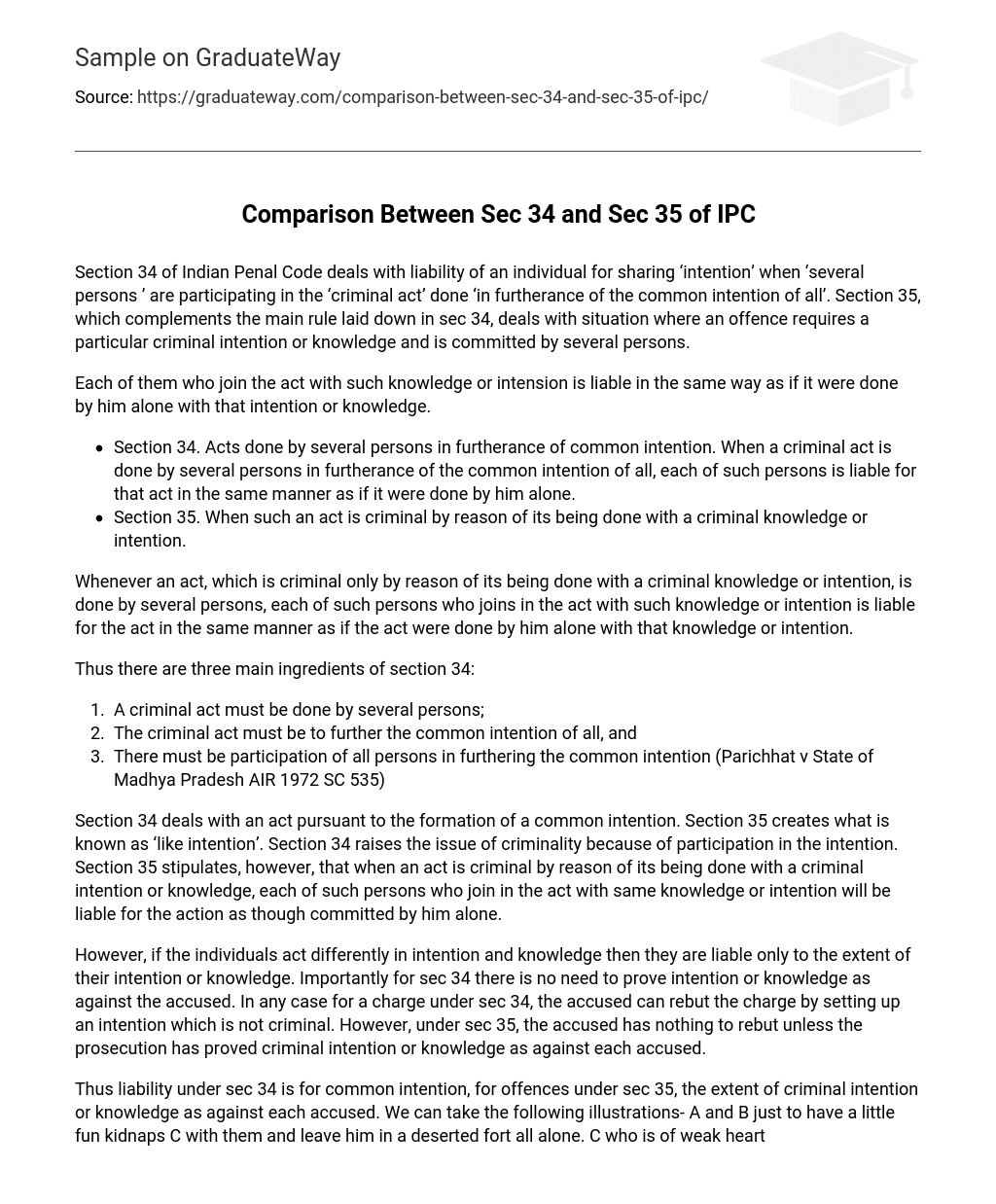Section 34 of Indian Penal Code deals with liability of an individual for sharing ‘intention’ when ‘several persons ’ are participating in the ‘criminal act’ done ‘in furtherance of the common intention of all’. Section 35, which complements the main rule laid down in sec 34, deals with situation where an offence requires a particular criminal intention or knowledge and is committed by several persons.
Each of them who join the act with such knowledge or intension is liable in the same way as if it were done by him alone with that intention or knowledge.
- Section 34. Acts done by several persons in furtherance of common intention. When a criminal act is done by several persons in furtherance of the common intention of all, each of such persons is liable for that act in the same manner as if it were done by him alone.
- Section 35. When such an act is criminal by reason of its being done with a criminal knowledge or intention.
Whenever an act, which is criminal only by reason of its being done with a criminal knowledge or intention, is done by several persons, each of such persons who joins in the act with such knowledge or intention is liable for the act in the same manner as if the act were done by him alone with that knowledge or intention.
Thus there are three main ingredients of section 34:
- A criminal act must be done by several persons;
- The criminal act must be to further the common intention of all, and
- There must be participation of all persons in furthering the common intention (Parichhat v State of Madhya Pradesh AIR 1972 SC 535)
Section 34 deals with an act pursuant to the formation of a common intention. Section 35 creates what is known as ‘like intention’. Section 34 raises the issue of criminality because of participation in the intention. Section 35 stipulates, however, that when an act is criminal by reason of its being done with a criminal intention or knowledge, each of such persons who join in the act with same knowledge or intention will be liable for the action as though committed by him alone.
However, if the individuals act differently in intention and knowledge then they are liable only to the extent of their intention or knowledge. Importantly for sec 34 there is no need to prove intention or knowledge as against the accused. In any case for a charge under sec 34, the accused can rebut the charge by setting up an intention which is not criminal. However, under sec 35, the accused has nothing to rebut unless the prosecution has proved criminal intention or knowledge as against each accused.
Thus liability under sec 34 is for common intention, for offences under sec 35, the extent of criminal intention or knowledge as against each accused. We can take the following illustrations- A and B just to have a little fun kidnaps C with them and leave him in a deserted fort all alone. C who is of weak heart dies of heart attack. Thus here though common intention of frightening C was there, it was not criminal. In another scenario, A and B who know that C is of weak heart and cannot bear such situations kidnap him to the secluded fort and leave him.
Their intention is to kill him. So here they can be convicted under sec 34 and sec 35 as there was a common intension (required under sec 34) and that intention was criminal also ( as required under sec 35) Moreover the act of kidnapping C and leaving him in the fort was a criminal act in the first illustration. Sec 34 holds them responsible for the act of kidnapping in furtherance of the common intention to frighten him. They cannot be charged under sec 35 as the common intention is not criminal.
Thus the major difference between the two sections is that sec 34 deals with only common intention while sec 35 deals with common intention which is criminal in nature. One of the earliest cases where the scope of sec 34 was considered at length was Barendra Kumar Ghosh v King Emperor. Here the privy council stated that section 34 deals with the doing of separate acts, similar or diverse, by several persons; if all are done in furtherance of a common intention, each person is liable for the result of them all.
So the accused might not have directly killed the victim and was simply standing as a guard during the robbery, but the mere fact that he knew of the pistol and was aware that such an incident can take place along with the common intention of committing robbery made him criminally liable for the act of killing. This principle was again stated in Afrahim Sheikh and Others vs State Of West Bengal on 7 January, 1964. Thus we can conclude that sec 34 and sec 35 form a part of each other, basically sec 35 compliments the rule laid down under sec 34.





